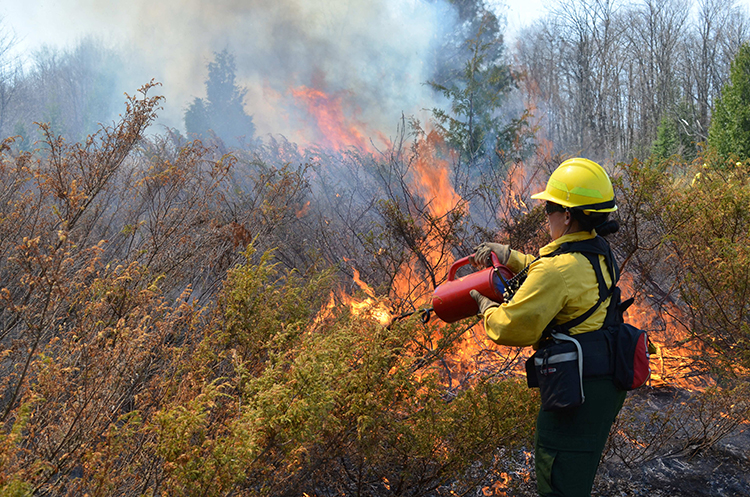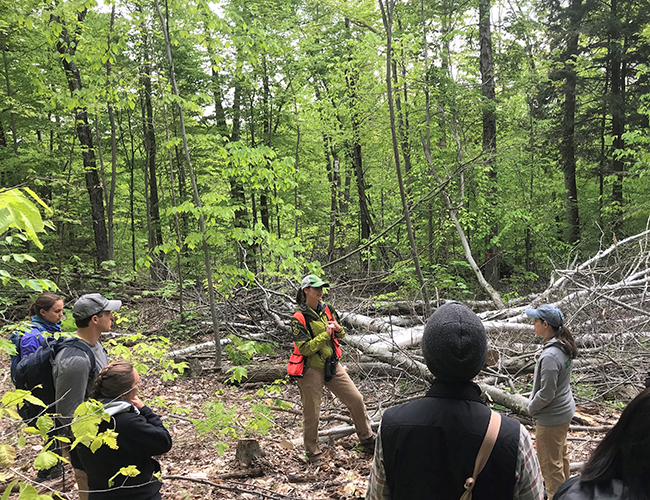White-Tailed Deer Rely On Quality Winter Habitats
Deer Management Is "Forest Management" In Northern States
Editor’s Note: This feature arrived courtesy of Craig Springer of the U.S. Fish & Wildlife Service, showcasing Pittman-Robertson funds at work.
Come April, white-tailed deer in the northern states have gone through their worst hard time. Prolonged severe winter weather is the most taxing time of all in the life of a whitetail, particularly at the edges of their northern-most range. Does will soon give birth — if they haven’t starved.
To get through this demanding period, whitetails “yard up,” or congregate in unique deer winter habitat. They gather in groups not for food, but to get out of biting winds and deep snow. In Vermont, for example, it is not uncommon for the winter mercury to drop below zero for more than 50 days over the course of the season. Add a foot and half of snow on the ground with piercing wind chills and one can see that winter habitat management is critical.
Taxes paid by firearms, ammunition and archery manufacturers via the Wildlife Restoration Act (Pittman-Robertson) fund state fish and wildlife agencies’ scientific population surveys and habitat management. That means ensuring the existence of robust stands of softwoods in sufficient size and frequency and proper locale to shelter white-tailed deer through the coldest part of the year.
“During winter months, white-tails migrate to important habitat for relief from deep snow and cold temperatures,” said John Austin, land and habitat program manager with the Vermont Fish & Wildlife Department. “Stands of softwood trees such as eastern hemlock, red spruce, balsam fir, white pine and white cedar — particularly on south-facing slopes where the sun creates favorable microclimates — provide critical habitat for deer to survive winter conditions.”
Austin continued, “Softwood tree branches capture snow overhead, making it easier for deer to get around, find food and avoid predators. Their reliance on this important winter habitat is about energy conservation rather than energy consumption. Deer in the northern part of their range depend on being able to conserve energy that was stored during the summer and fall when food is abundant.”
Ryan Robicheau, wildlife management section supervisor with the Maine Department of Inland Fisheries & Wildlife agrees.
“Whitetails in winter are basically in starvation mode this far north when they can’t access herbaceous plants under the snow cover. Winter foods are not very nourishing, and deer put their attention into conserving energy,” he said.
Habitat Conservation Front & Center
In northern Michigan, the situation is not a great deal different.
According to Steve Chadwick, assistant chief of the Michigan Department of Natural Resources, the winter period in the upper peninsula and top of the mitten that is Michigan, is severe and long-lasting. Proper forest habitat more than anything is important to deer survival, according to Chadwick.
“Stands of lowland cedar trees and other conifers let deer get out of the wind and deep snow,” said he said. “Regarding deer management, we have used Pittman-Robertson dollars over a span of time to buy land and manage it for deer wintering habitat, and that has been crucial to our success.”
Pittman-Robertson is the source funding for adding to wildlife management areas (WMAs) in Maine, as well. Robicheau says his agency has put a great deal of effort in acquiring winter deer habitats. This spring, the agency expects to add 10,000 acres to its existing 120,000 acres of WMAs. That’s substantial, says Robicheau, in a state comprised of mostly private lands.
“Deer are the priority species on these lands, but so much other wildlife benefits, too: songbirds, and furbearers such as martin, fisher, coyote and bobcat,” he said. “Hunters, birders and trappers benefit, as well.”
Habitat conservation is front and center in Vermont, according to Austin.
“Maintaining deer winter habitat is a vital factor in managing our herd. We use Pittman-Robertson dollars to regularly map habitat, so we know what we have and can manage accordingly,” said Austin. “Vermont is 75% forested, so deer management is closely tied to good forest management including selective thinning to create gaps and forest regeneration.”
Austin continued, “While the Vermont landscape is largely forested, only 9% of that area supports deer winter habitat, making it all the more important that we manage and protect those areas carefully. Pittman-Robertson funds are essential to wildlife management — those dollars make it happen.”
In 2023, Vermont received $7.1 million; Michigan $34.6 million and Maine $13.2 million in Wildlife Restoration funding — all derived from federal excise taxes. In order to utilize these funds, state fish and wildlife agencies are required to match them by 25% with non-federal funds, usually generated through the sales of hunting licenses.
Visit “Funding Sources” at Partner with a Payer to learn how much Wildlife Restoration funding your state agency received in 2023, and years past.
For more stories like this one, check out how Pittman-Robertson funds facilitated a hunting area purchase in New Mexico.






